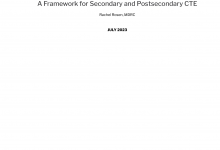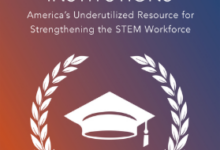NAPE’s report shares on the challenges and promising practices of the IM STEM initiative which used the collective impact model in a cross-state collaboration to create systems changes in state-level agencies and organizations with the goal of providing diverse students access and opportunities for success in STEM and CTE. The report discusses the projects efforts to bring together stakeholders and build a network across six states over the past two and a half years as well as outlining the challenges and successes that were had in those efforts. Readers will learn the key components of the collective impact model chosen by the IM STEM initiative:
- Backbone Support: An independent, dedicated staff provides support and key functions for sustained operation of the collective impact initiative;
- Common Agenda: All participants share a vision for change that includes a common understanding of the problem and a joint approach to solving the program through agreed-upon actions;
- Continuous Communication: All players engage in frequent, structured communication to build trust, assure mutual objectives, and create common motivation;
- Mutually Reinforcing Activities: A diverse set of stakeholders, typically across sectors, coordinate a set of differentiated, mutually reinforcing activities; and
- Shared Measurement: All participants agree how to measure and report on progress, with a short list of common indicators identified to drive learning and improvement.
The report details how the initiative implemented each of the five elements of the collective impact model, relevant evaluation outcomes, challenges that the initiative experienced, and lessons learned in hopes that others attempting to use this model of collaboration for a multi-state approach to systems change can learn from the experience. Through this report state leaders will learn how to creatively implement collective impact models in their states focused on equity and access within STEM programs and careers while avoiding common challenges that can occur in the process.







